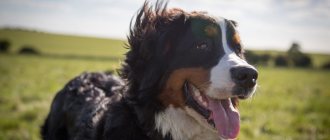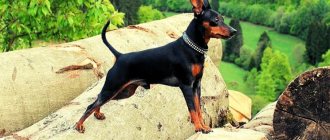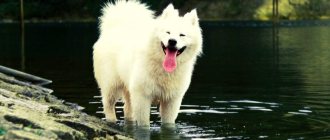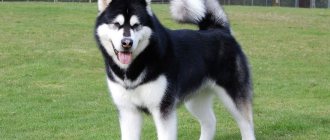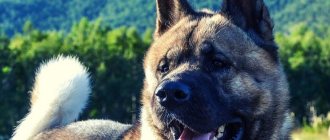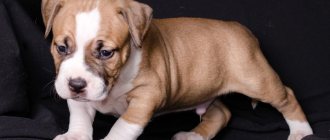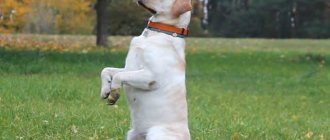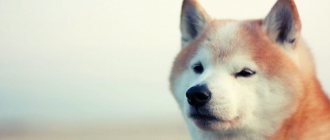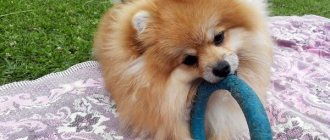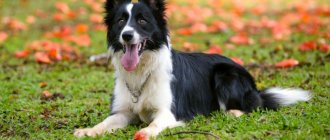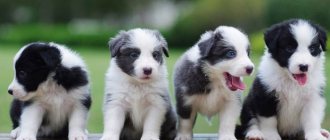| Aggressiveness |
| Upbringing |
| Training |
| Intelligence |
| Shedding |
| Behavior with children |
| Watchman |
| Security guard |
| Difficult to care for |
| Endurance in the cold |
| Endurance in the heat |
| Great Britain | |
| Lifespan | 12−15 years |
| Height male | 48–56 cm |
| Rising bitch | 46–53 cm |
| Weight male | 14-20 kg |
| Weight bitch | 12–19 kg |
The Border Collie, or Scottish Shepherd, is a brave, hardy, unpretentious dog.
This is the dream of a shepherd who worries about the integrity of his flock. But in modern conditions, when dogs have little use in dealing with herds of sheep, they become excellent companions and friends of humans. They win at exhibitions and competitions thanks to their ability to quickly learn agility, freestyle, and flyball. If you are an athlete who is constantly on the move, or an active person who never sits idle, you need a dog to match you. The best candidate would be a border collie breed. Her friendliness, activity and great intelligence will make her an interesting and irreplaceable companion.
The breed belongs to group 1 in the ICF classification, section 1 “Shepherd dogs”.
Origin, history
The ancestors of the Border Collie were herding dogs that lived on the border of Scotland and England. The mountainous terrain was suitable mainly for cattle breeding, and in order to herd numerous herds of sheep, dogs that were hardy, light, fast, and not aggressive towards humans were required. These were the collies, the first mention of which dates back to 1570.
And after Scotland became part of Great Britain and the beginning of the development of large sheep farms, attention to herding dogs became even greater. In the 19th century, a collie dog was first exhibited at a dog show in Birmingham County. Until the advent of the breed standard in 1881, breeders experimented with crossbreeding, which resulted in red and merle colored dogs.
Interesting! There is no consensus on the origin of the name of the breeds. The word “border” comes from the English “border” - border, reflecting the fact that the breed appeared on the border between England and Scotland. The etymology of the words “collie” is controversial. There are several versions:
Version No. 1. The dogs were named after the Scottish breed of sheep with a black tail and black mask that they herded. These sheep were called "colley".
Version No. 2. The dogs got their name from the word “coaly”, which means “coal black” due to their common color.
Version No. 3. Derived from the English word "collar", meaning "collar" and referring to the dog's beautiful mane.
Whatever the history of the Border Collie breed, in modern times it is very popular throughout the world. The dog is used for various purposes: as a companion, as part of sanitary, rescue and search teams, in pastures.
Scottish Sheepdog breed standard
The collie is a slender aristocrat with a slightly sly expression on his long muzzle and an equally cunning look. Despite the fact that today's individuals no longer herd sheep that have strayed from the herd, a strong build, without a bias towards coarseness and dampness of the bones, remains the defining feature of the breed. As for the dimensions of long-haired shepherd dogs, each standard describes them differently. For example, according to FCI specialists, the height of a model collie male is 56-61 cm, and that of a female collie is 51-56 cm. At the same time, the AKC (American Kennel Club) offers its own standards: 61-66 cm for “boys” and 56-61 cm for "girls".
Abundant straight hair, reminiscent of an elegant coat, complemented by a fluffy collar and fluffy tail, is another spectacular attribute of the long-haired variety of the breed. However, it is important to understand that even a record-breaking voluminous and glamorous “outfit” is not able to cover up the physical shortcomings of the animal. To put it simply: in the show ring, the condition, movement and bone structure of a collie are judged more scrupulously than the coat. This happens because historically the ancestors of Scottish Shepherds were bred as working dogs, which means they were much poorer dressed. At the same time, the luxurious “robes” of today’s representatives of the breed are just the result of breeders’ persistent desire for a standard photogenic exterior of their pets.
Head
The elongated dry head of the Scottish Sheepdog should have a blunt wedge shape, but not copy the head of one of its ancient ancestors - the greyhound. The collie's skull and cheekbones are flat, the stop is poorly defined. The head and muzzle are approximately the same length.
Eyes
The main sign that this is a Scottish Shepherd is the sly look of the slanted almond-shaped eyes, which Western breeders characterize as “sweet.” The most common iris color is dark brown. The exception is individuals with marbled fur, for which a blue eye tone is acceptable, as well as heterochromia.
Jaws and teeth
The teeth are large and complete. The jaws are strong, in a scissor-shaped jaw.
Nose
The back of the nasal part of the muzzle is characterized by a slightly rounded shape. The earlobe has a rich black tone.
Ears
Relatively small, the Scottish Shepherd's ears are set at the top of the head and are laid back. The ear flap assumes a semi-raised, forward position only if the dog is interested or worried about something.
Neck
The Collie's muscular, balanced neck should have a pronounced arch and sufficient length.
Frame
The body of an elongated format is an external feature, especially pronounced in females. The back of the Scottish Shepherd is strong, slightly raised in the lumbar region. The chest is deep, wide behind the shoulder blades, with elegantly rounded ribs.
Limbs
The front legs are dry, with oblique shoulder blades, straight forearms and elbows pointing straight back. The hind limbs have a muscular thigh and sinewy lower limbs. The hocks give the impression of restrained power and are dropped downwards. The dog moves at a light, slow trot, pushing off springily with its hind limbs.
Tail
The collie has a long tail, the lower vertebra of which is at the level of the hock joint. When a dog is relaxed, its tail is held downwards and slightly curled upward at the tip. If the animal is excited, the tail is carried cheerfully, but is not thrown over the back.
Wool
The rich undercoat hugs the collie's body tightly, completely hiding the skin. The outer coat is rough, straight, forming a lush mane and frill on the neck, feathering on all four legs and an exquisite “fan” on the tail. The hair on the ear tips and head is short and smooth.
Color
The standard fixes no more than three basic suits:
- sable - all options from lightened gold to darkened sable, with the exception of light straw and cream;
- tricolor – coal-black with red-brown markings;
- blue merle - silver-blue with black narrow streaks and spots, as well as tan markings on the top of the head and legs (the latter quality is optional).
A preferred addition to the color is also the presence of a white shirtfront, collar, tip of the tail and white spots on the paws.
Defects and disqualifying defects
Representatives of the breed are disqualified for cryptorchidism, anatomical deformities, aggressive lunges or excessive cowardice and malocclusions. Any noticeable deviation from the standard is sufficient to reduce the exhibition rating. For example, dogs with an insufficiently filled muzzle, protruding cheekbones and occipital protuberance, and incomplete dental formula will not be able to qualify for the championship. The same fate awaits Scottish Sheepdogs with a short stocky body, erect ears, soft hair and cow-like legs.
Characteristics, description, character
If you are the owner of a border collie, then you are a real lucky person, since the pet constantly infects you with its energy, activity, cheerful disposition and friendliness. The Border Collie, whose character was formed at the time the breed appeared, is a very positive dog.
It has:
- Great mind. At the University of British Columbia in Canada, a group of scientists led by psychologist Stanley Coren conducted a series of studies, based on which it was proven that the border collie is among the top smartest breeds, moreover, it tops this list. It is high intelligence that explains the high ability to learn, understanding the owner’s desires the first time, and intelligence.
- Balance and calm. These qualities make the dog an excellent pet for families with children. You don’t need to expect inexplicable, spontaneous actions from her and you can be sure of the safety of the children.
- Energy, activity and hard work. They devote themselves entirely to their work, no matter what it is: working in the pasture or participating in exhibitions or competitions. To throw out the energy that is overflowing, the collie must run a lot and do physical exercises. Under no circumstances should you let her get bored and idle, otherwise her energy will be directed in the wrong direction: the dog will begin to damage the furniture and chew everything around.
- Devotion. The collie is ready to guard its owner everywhere and always, being extremely wary of strangers.
The Border Collie, whose description became officially recognized in 1988 in standard No. 297, is a strong, graceful, robust and resilient dog. Its weight is 14-20 kg for males and 12-19 kg for females. Females and males of the breed grow up to 46-53 cm and 48-56 cm, respectively.
The Border Collie develops great speed without almost lifting its paws off the ground. Features of the appearance of the breed:
- Long or short hair. The thickness of the coat, soft and dense undercoat protect the dog from bad weather. Such hair was a real salvation when the dog served in the pastures in harsh conditions in the mountainous areas of Scotland.
- The Border Collie can have any color, the main thing is that white does not predominate. Most often you can have black dogs or black and tan. Brown and merle puppies are also born. White markings are located on the tip of the tail, the muzzle in the form of a groove on the forehead and between the eyes, the limbs and in the form of a collar on the neck.
- The erect or semi-erect ears are set wide apart.
- The head tapers towards the end of the muzzle.
- Elongated, muscular body with a broad chest.
- Low-set tail, covered with thick hair.
Character and other features of the border collie
The main character trait is high performance. This dog is a workaholic, she is only interested in those who work with her or play with her.
Photo: Trevis Rothwell
Roughly speaking, if the owner does not have a ball, but the coach does, the border player will go with the coach. Needs work 3-4 hours a day, gets bored without work. This is a typical choleric person by temperament. She needs to constantly come up with tasks; she won’t be able to entertain herself.
Small children are not interested in this breed; it is better not to leave a child under 8 years old alone with an energetic, strong dog. But they get along great with teenagers.
They train well; even a novice trainer can teach them commands. This breed is considered the smartest among dogs, holding the record for the number of commands remembered and executed. Commands are carried out with lightning speed and precision. Even if a dog is prowling in the bushes “on its own wave,” when given the command “down” it will fall as if shot. The characteristic behavior of the Border Collie is well described in the book “The Year of the Dog” (by John Katz).
Video of a Border Collie performing brilliantly at an agility competition
Border collies also show excellent performance when using clicker training (this is a popular method of positive education of animals using treats and a sound marker. When the animal behaves as desired, a sound signal is given and a treat is given).
Photo: Katherine
Border Collies mature late. Growing up can last up to 2-3 years, during this period dogs behave like puppies, and sometimes stupid or funny stories happen to them. It is believed that this breed is characterized by a “hypnotic” pensive look with which it mesmerizes cattle. And the gaze that shows the cattle who is boss is called the “eye.”
The smartest dog
At the University of British Columbia (Vancouver), experiments were conducted to determine the level of intelligence of dogs and a list of 10 breeds was compiled. Topping the list were border collies. Their level of mental development is similar to that of a two to four year old child. They know at least 200 words, distinguish certain signals and gestures, and are able to add and subtract within five.
Video demonstrating the abilities of the border collie Border collies easily determine their position on the ground and can control the simplest machines. Considered the best shepherd, he has amazing performance.
Positive traits of the breed
The benefits of the Border Collie include:
- sharp mind
- amazing work ethic (can work up to 12 hours a day)
- discipline
Photo: Corinne Benavides
- determination
- intelligence
- high learning ability
- diligence
- observation
- energy
- endurance
- adaptability
- insight
- susceptibility
- do not require praise or encouragement when working
- gets along well with other animals
- not aggressive
- excellent memory
- excerpt
- ability to analyze.
The border collie Rico is considered the smartest dog in the world. He knew about 250 different words and commands. During the experiment, Rico was asked to bring an object whose name was unknown to him. The unfamiliar object itself was placed among the toys known to him. And the dog guessed to bring that thing whose name it didn’t know! And Chaser from the UK, who is engaged in a special program with psychologists, already knows more than a thousand words, divides them into categories and continues to learn new words
Negative traits of the breed
Among the disadvantages of this breed are the following:
Photo: Bill Blevins
- don't tolerate loneliness well
- sensitive to noise
- don't like crowds
- Preschool children are embarrassing - the dog doesn’t know how to behave with them
- require an active, knowledgeable owner
- training is definitely needed
- requires a “firm hand”, the owner cannot be “weaker” than the dog, otherwise it will become uncontrollable
- will work with anyone, needs 3-4 hours of daily work
- requires constant physical and mental stress, without them it is prone to self-destruction, damage to property, and a state of rigidity may arise (obsessive actions, “getting stuck” on some process). The owner must be in good physical shape
In the absence of sheep, the border collie will “herd” children, adults, owners, and try to herd neighboring cats into the herd
Purpose of borders
It has been noted that Border Collies perform best in certain “professions.”
A still from the film “Year of the Dog” (USA, 2009), one of the characters of which is a border collie dog
For example, they make excellent:
- shepherds
- athletes
- actors
- rescuers
- guides
- bloodhounds
Who is the Border Collie suitable for?
Photo: david reid
Such smart and hardworking dogs will be appreciated by a sporty, active and unpretentious person. Strong physically, in need of a companion for many kilometers of hikes, runs, training and competitions. Or a cattle farmer. The breed is not for apartment gatherings and snuggling on the sofa, not for a family with a small child or elderly people.
A homebody or someone who wants a loyal companion will be disappointed - this collie will go with anyone who offers him a job. If you are not ready to load him up 3-4 hours a day every day or expect protection from him, this is not the dog for you.
Photo: Trevis Rothwell
If you need an intellectual, a workaholic, an athlete - a champion in frisbee, agility, canis freestyle, obedience, tracking, flyball, the best shepherd in the world, if you are an experienced dog breeder, familiar with the clicker training method, you can devote several hours to working with the dog day – you couldn’t find a better border collie.
Diseases
Border Collies, like any other dog, are prone to certain diseases that are acquired or hereditary and can shorten the animal's lifespan.
- Diseases of the musculoskeletal system. Hip dysplasia, which can result in lameness. You can suspect the disease based on its symptoms: it is difficult for her to move after sleep or physical activity, she has a limp. Osteochondritis dissecans causes joint degeneration.
- Eye diseases. After 2 years of age, Border Collies may be diagnosed with progressive retinal atrophy. The first “bell” may be that the dog stops seeing in the dark and at night. Regular examination of your pet's eyes is a mandatory procedure that should be carried out in a veterinary clinic.
- Collies have epilepsy - a serious disease, during attacks of which the dog can die.
- Congenital deafness. If a puppy is born with a white color on its head, then there is a risk that it is deaf.
- Allergies and skin problems caused by insects, mites.
Care and maintenance
The Border Collie's coat, despite its length, is easy to care for, as it tends to repel dirt, so to maintain cleanliness, the dog needs to be brushed 2-3 times a week for 10 minutes. When a dog sheds, perform the procedure more often so as not to find hair on the furniture and floor. The Border Collie takes care of it positively if you teach it hygiene procedures from puppyhood. He will enjoy brushing with a brush.
The breed is clean and does not have a characteristic dog smell, so it does not need to be bathed often, 2-3 times a year is enough. If your dog gets very dirty during a walk, you can give it a bath. Veterinarians advise paying attention to the following point: if your pet starts to smell bad after bathing, you should consult a doctor, as this may indicate skin problems.
Eyes and ears do not require special care. Collie ears are ventilated and rarely get infected. Regular cleaning of the ears from dirt and eyes from crusts accumulating in the corners is the only requirement for caring for these organs.
A dog's teeth are strong and rarely develop plaque. But if it appears, then you can add tomato juice to your food, which will eliminate imperfections in the form of dental plaque.
Collie is not a dog for “four walls”. He needs physical activity, a lot of space where he could waste his energy. You need to walk with him at least 2 times a day for 45 minutes. Slow walks are not for the Border Collie. Energy is in her blood, so playing with a ball, frisbee, running over obstacles or running after an owner riding a bicycle is the best thing that can be offered to a dog during walks. The collie has a very strongly developed shepherd instinct, so he can begin to herd his owner, pigeons in the park, and even a broom in the yard.
External data of the breed
The basic parameters need to start with the weight and height of the dog. The growth of pets of different sexes is different. Females are smaller in size: from 47 cm to 52. Males are slightly larger, their height varies between 50-53 cm. The weight of dogs of this breed is between 15-20 kg.
The head is proportional to the body, neither large nor small. The ears are sharp and always in a standing position. The shape of the pets' eyes resembles an oval. Eye color - brown. The nose is most often black, but there are also dark shades, this may depend on the color of the dog. The jaw is strong and the grip is strong. The pet's muscle corset is well developed. The neck and body itself are strong. The tail is covered with hair and is long in size.
You need to pay special attention to your pet's fur. There are different colors. This breed has long-haired and short-haired coats. If you carefully watch the dog while moving, you will notice that the movements seem to be perfected. They move smoothly and slowly.
Important! If your pet is predominantly white in color, then it will not be allowed to compete.
Training and education
Raising and training a border collie is a pleasant experience for the dog and its owner. Thanks to their high intelligence and quick wit, the breed is very trainable and can learn a command in a matter of minutes. Despite their intelligence, not a single dog, including collies, learns on their own, so the participation of a patient and attentive owner is necessary.
Border collies, whose character is determined by their herding background, during walks and training can be distracted by any object that can be touched, so the owner’s task is to become an authority for the dog, to whose call and command the dog will always respond, despite even his instincts shepherd dog.
Representatives of the breed are excellent fetchers. While walking, they love to catch objects. They even catch soap bubbles, a stream of water, and love to hide and seek with their owner or search for a hidden toy.
Border Collie Training Tips:
- Rudeness and punishment must be eliminated. Only positive motivation: treats, games or praise will help achieve the desired results.
- The dog can be distracted by everything that happens around him, so it is important to train him to pay attention.
- During training, you need to stay away from sources of loud noise. The breed is very sensitive to noise and may become frightened or constantly distracted by it.
If a dog is chosen for sporting success, then a border collie is an excellent option. They show high results in such disciplines as freestyle, agility, frisbee dog.
But the greatest pleasure for the breed is to let it do herding work, during which it is taught basic commands. Training your dog will be a breeze.
When to start training a dog
As soon as a collie puppy appears in your home, immediately begin to build a relationship with him. From the first day it is necessary to provide him with everything he needs: bowls for water and food, collar, leash, bed, suitable food, toys and of course treats. You need to give him a lot of attention so that he feels safe and begins to trust you. From a very early age, a collie puppy needs to be introduced to commands. In addition, in the first months it is necessary to study commands both at home and on the street. First, the puppy must remember its name. We wrote how to choose a suitable nickname in one of our articles. The name should be short, easy to remember and the dog should be called only by it. When the pet has already mastered its name and finally begins to respond, then we move on to commands. By the 3rd month he should master the following commands: “Ugh!”, “Come to me!”, “Place!”, “Nearby!” and “Fetch!” (optional). Then you can move on to the rest, of course, if you need them.
Puppies
At 2-3 months, when a puppy moves from the nursery to a new home, he can already do without mother’s milk. The number of feedings at this age should be 4-5 times and should be fed with fermented milk products.
There is a little secret that will make training a puppy easier with the help of food motivation: those foods that the dog loves and are planned to be used as treats during training should not be included in the general diet. Most often, these products include hard cheeses, chicken, liver and other options for dog delicacies.
Price
Everyone who is fascinated by this wonderful breed is concerned with the question: how much does a border collie cost? Despite a whole list of advantages, the breed has never been prestigious or super popular, so its prices are quite affordable. On average, it costs from 15 to 25 thousand rubles.
The most reckless thing to do when choosing a future pet may be to buy it second-hand. In such a situation, they will ask for no more than 1-5 thousand rubles for a puppy, but there is a risk of getting not even a border collie without a pedigree, but a mongrel with a similar color.
In nurseries, prices are higher, but they provide guarantees and documents. Pet-class puppies, destined to become devoted pets, cost up to 10-15 thousand rubles. Breed class suitable for breeding - 15-18 thousand rubles. And high-class puppies, which are predicted to win competitions, will cost 18-25 thousand rubles.
Also, prices may vary depending on the color of the dog. As a rule, brown puppies are valued higher.
Character of the Scottish Sheepdog
Collie is a charismatic intellectual who knows how to build warm relationships not only with the owner and his family members, but also with furry “antagonists” in the form of other dogs and domestic cats. One of the most pleasant and rare qualities of the breed is the absence of extremes in character and temperament. We can say that in its soul the animal carefully weighs the validity of each action, fearing to overdo it, therefore the correct Scottish Shepherd is playful and active, but will not create something like a natural disaster in the house; she is eager to contact the owner, but never transforms into a delivery dog, from whose attention you want to hide in another room.
In relations with strangers, furry aristocrats are also extremely diplomatic - despite the natural distrust of a stranger, the long-haired collie will not allow itself to descend to a threatening growl and display of fangs. That is why the breed is reluctant to become a bodyguard, preferring to trust its representatives with search and guard work. Shepherds have a permanent partnership with children, so if your heirs need a patient and inexhaustible nanny, take a closer look at the collie. The only caveat: to achieve maximum effect, you will have to raise the future “babysitter” yourself - dogs that have not had contact with children until adulthood, alas, are not so child-loving.
Almost all dog handlers note the unusual talkativeness of the breed. And it’s not just about the vocal reaction to intrusion or extraneous sounds - a true “Scotsman” is not averse to chatting with the owner for no reason. So don’t be surprised when, in response to a word spoken to your pet, you hear something grumbling, shrill or howling. In relation to other representatives of the fauna, Scottish Shepherds behave in a reserved and peaceful manner, and they carefully protect small livestock and poultry from encroachment. A collie can only present unpleasant surprises by succumbing to collective euphoria. For example, when a pack of other dogs chases a cat or a bird. A four-legged shepherd will most likely join in such a fun activity - whatever one may say, pack instincts still play a significant role in the life of shepherd dogs.
Take into account the fact that there are no dogs that are exact copies of each other, both in appearance and in behavior, so it is pointless to compare the puppy you got and the one that lives in a friend’s house. Often, differences in the character of animals are also due to the geography of breeding. For example, dogs from American lines are more temperamental than their European relatives. By the way, in terms of physical activity, Scottish Shepherds, although lively, are quite manageable, which cannot be said about their cousins - short-haired collies, whose internal battery always works at the limit of its capabilities.
Photo
The Border Collie, photos of which are presented below in the gallery, is an intelligent and cheerful animal that will brighten up the life of an active and cheerful person. Walking and playing together will make the pet and the owner best friends.
Meet a unique dog whose history dates back to the Viking cattle dogs. In modern times, a dog can perform different tasks; its main enemy is inaction.
